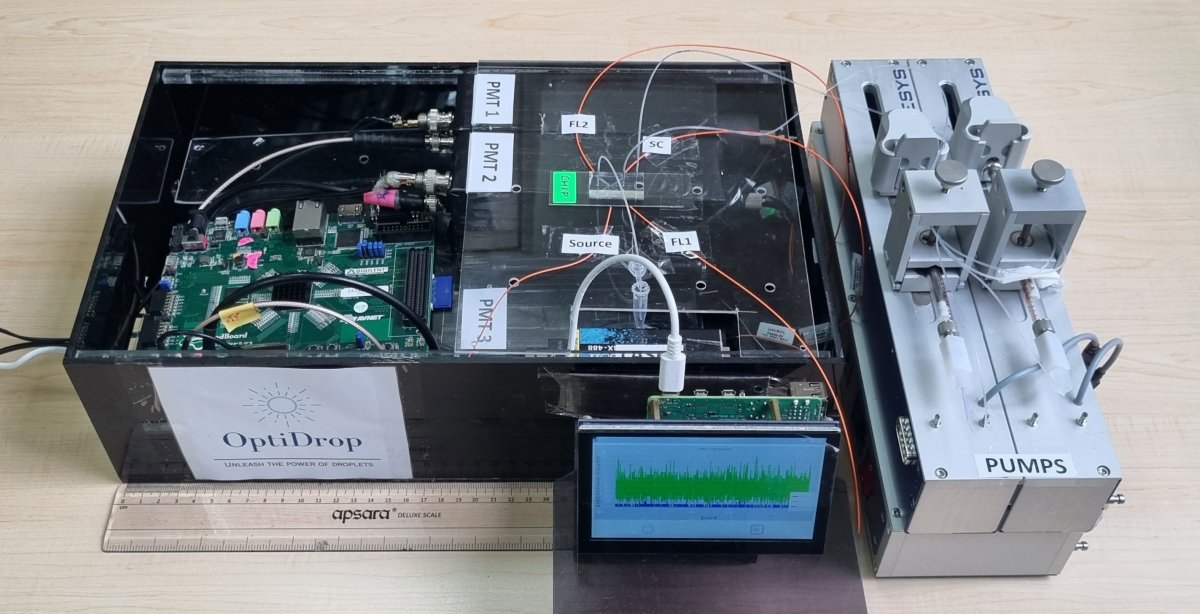C-CAMP develops new OptiDrop platform to study single cells
The Centre for Cellular and Molecular Platforms (C-CAMP) in Bengaluru has developed a new platform that makes it easier and cheaper to study single cells. Named OptiDrop, the platform has potential applications in diagnostics, therapeutics, agriculture, and animal health. The findings were recently published in Nature Microsystems and Nanoengineering.

The novel microfluidic chip-based platform allows for optical sensing of biological samples without the expensive open space, bulky optical components routinely used in microscopy and flow cytometry-based techniques.
This innovation, developed by C-CAMP's Discovery to Innovation Accelerator team enables the study of single cells encapsulated in droplets with ease and precision. The platform's affordability, live data visualisation, smaller data footprint, and 'closed' system design (preventing external contamination) make OptiDrop a viable benchtop technology for broad clinical applications.
“Traditional flow cytometers, used for fluorophore-based biomarker detection, are limited by high costs, bulkiness, and larger sample volume requirements, often restricting their usage to few hospitals, research or diagnostic labs. Optidrop will have game-changing downstream applications, including studying the impact on individual cells during a drug screen, environment control (water contamination counter), detection and sorting of CAR-T cells in immuno-oncotherapeutics, selection of CRISPR-modified single cells and selection of high-efficiency clones in single-cell genomics,” explains Dr Taslimarif Saiyed, CEO and Director of C-CAMP and one of the lead authors of the paper.
How does it work?
The team, consisting of researchers from C-CAMP and IIT-Madras, developed OptiDrop using a proprietary microfluidic chip with integrated optical fibres, photomultiplier tubes and a pulse counter. As each droplet flows through the microfluidic channel lit by an incident beam, light is scattered from its surface and contents. The platform detects fluorescent signals associated with the individual droplet. The output or signals are captured, processed and read live through an in-house developed software.
Prof. Anil Prabhakar, one of the authors of the paper from the Department of Electrical Engineering, IIT-M said the work is the result of a long fulfilling collaboration between IIT-M and C-CAMP. He added that one of the most important parts of the technology was aligining the centre of an optical fibre to the centre of the fluidic channel and it was achieved through proper co-design of both optics and fluidics.
To validate OptiDrop's capabilities, the team carried out an antibody-based protein biomarker detection study. The results were on par with those obtained from standard flow cytometers, underscoring OptiDrop's reliability for scientific research. “We will continue our explorations with different cells and different fluorophore combinations, and optimise the optoelectronics used in the system,” adds Prof. Anil Prabhakar.
How much does it cost?
Flow cytometers currently available in the market can cost anywhere between INR 45 lakhs and a crore. OptiDrop setup costs only about INR 10,00,000, and depending on the requirements of the application, the cost of light sources, detectors and pumps can be reduced by replacing these components with lower-cost alternatives for larger-scale production without compromising the sensitivity of the device.
OptiDrop can also provide instant phenotypic information based on protein biomarkers or nucleic acid detection and also help in the customizable sorting of droplets creating an on-demand selection of cell populations based on optical properties.
The OptiDrop platform lays a foundation for future enhancements in the speed, sensitivity, and accuracy of optical sensing for single cells within droplets, and promises a broad scope of applications in biomedical research and diagnostics such as single cell genomics, cell selection for oncotherapies, iPS stem cell sorting, rare cell identification, multiplexed diagnostic assays, high throughput phenotype-genotype matching, hybridoma selection and drug screening.
The work was supported by Biotechnology Industry Research Council (BIRAC), Department of Science and Technology (DST) and the Ministry of Human Resource Development (MHRD).
Date:
April 4, 2024
News Link:
